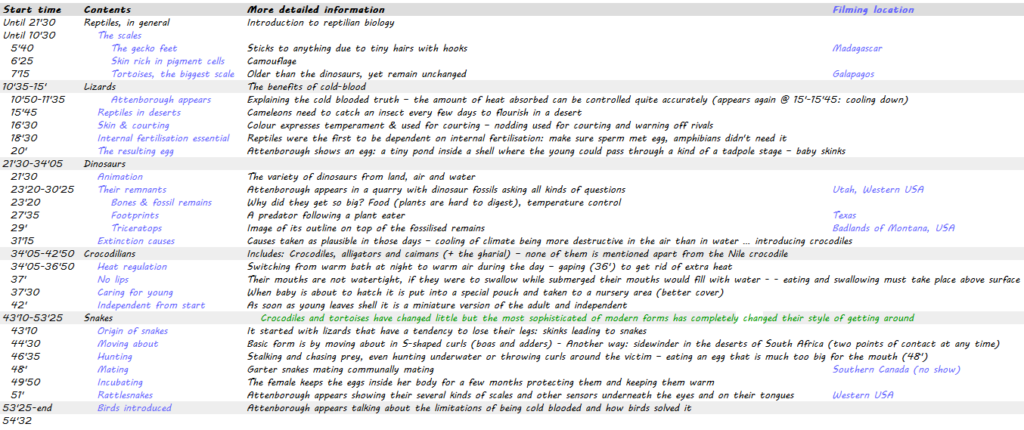Original air date: 27 February 1979
This episode is about the reptiles. It is more equally balanced between different groups than the previous two.


As the outline above shows the episode starts with a general overview of the scale, while doing so a few groups are expertly dealt with to take care of various benefits of the main reptilian characteristic: the scale and then gradually drifting towards the larger groups.
Sequences of interest
The start and end of their take on the birth is quite different from what would be expected: they start with a mating game among turtles but after its incubation other groups are dealt with (18’30-21’50).
Playing with the light

Switching between turtles and snakes it seems the cameraman filmed some interesting shots of sunlight with snakes and turtles. These were used to connect crocodiles (talking about them being very ancient like turtles) with snakes. Notice the subtle change when the focus drifts from the tortoise to the snake: A tortoise is seen vanishing in the darkness past the sun, shining on to the lens. Then the scene blends into another where the focal point is the eyeball of a snake (notice the frames around location where the two come together). This is a brilliant mixture of scenes.
Animals appearing: (in addition to the Nile crocodile)
Mainly lizards: Marine iguanas, Australian thorny devil (3′), shingleback (skink = lizard, 3’25), Australian frilled lizard (4’45), horned iguana (5’30), geckos (5’50), Madagascan gecko (6’30), chameleon (6’40), earless dragon (6’48), giant tortoise (7’20), anolis lizards (16’45), green iguana (17’05+20’50), skinks (21’25), monitor lizard (39’26), Australian blue-tongued skink (43’40), South African skink (43’45) and in the end, Australian scaly foot (lizard, 44′).
Dinosaurs: Deinonychus (22’55), Tyrannosaurus rex, triceratops (29’20), Stegosaurus, parasaurolophus, brachiosaurus, allosaurus (24’50) & brontosaurus (25’40).
Snakes: pythons (44’45), boas (44’51), puff adder (45’20), sidewinder (45’35), Florida mud snake (46’55), egg-eating snake (47’10), prairie garter snake (48’20) & western diamondback rattlesnake (51’15).
Coming up:
But being cold-blooded, solar-powered, does have its limitations. No reptile can survive sustained cold, so great areas of the world are closed to them. But a very long time ago, one group of the reptiles evolved an answer to that problem. An answer that was based on that versatile thing, the reptilian scale. A feather.
Filming locations
Galapagos – Attenborough talking about the largest scale of all, the carapace of tortoises. Later he talks about the qualities of being cold-blooded (7′-16′).
In Utah, USA Attenborough showed bones from the dinosaur era (23’30)
In Texas, he had a look at fossilised footprints of dinosaurs (27’30)
He went to the Badlands of Montana for other bones (29′)
Additional filming locations (without Attenborough): West Indies (5’30), Southern Canada (48′), central Australia (6’50), Fiji (17’05), Australia (43’40), South Africa (43’45), South-West Africa (45’35) & Florida (46’55).